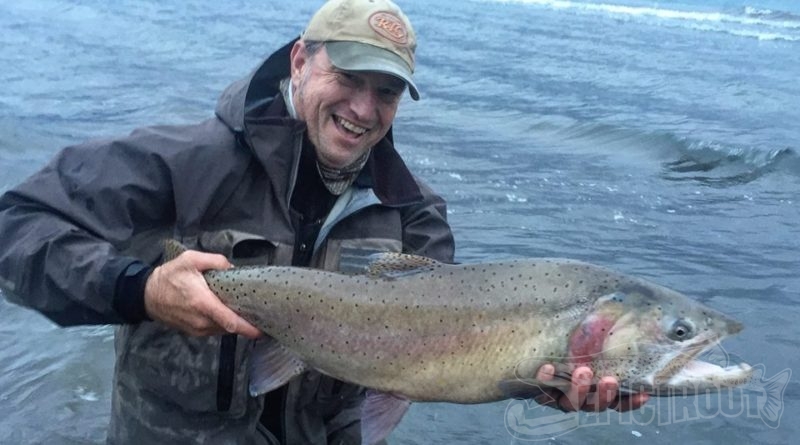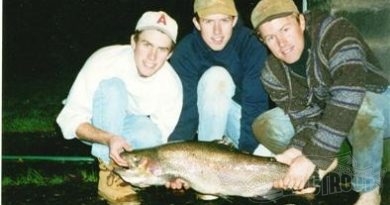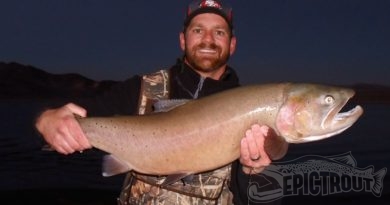Switching it Up, Pyramid Lake
Strip, strip, strip, SET! With the line grabbed tightly in my left hand and a solid pull, in conjunction with a side sweep the 11’9” rod bows deeply to the head shakes of another giant Lahontan trying to rid itself of the size 2 woolly worm now buried in its jaw. In the past couple of years you may have noticed some longer than average fly rods out in the ladder line up at the popular beaches of Pyramid lake. The Switch rod, a hybrid cousin of the full Spey rod, is now almost a common sight, giving fly anglers another tackle choice or maybe I should say another choice to tackle as I came to find out. The excitement of a new technique, coupled with the anticipation of untested tackle found me with high expectations and doing my research. What I thought would be the simple answer to the problems I was facing turned into a real learning experience. Only after practicing a new casting method and re-thinking my options came the sought advantages of a switch rod over a single hand rod.
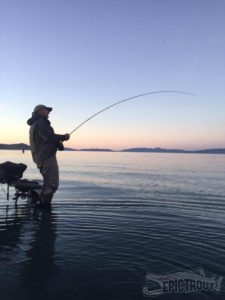
The main questions I am faced with are Why should I try/buy a switch rod? What are the advantages? Is it worth the time and money invested? Now speaking from personal experience, the first and foremost answer to all of these questions is that fishing, casting and catching trout on a switch rod is fun. Flat out, shooting 100’ of running line, leaning back straining the blank into a giant C against a backing burner, big long rod bending over into the water, walking to shore in tow, fun. This is something I didn’t expect. For me I was looking at the steelheaders and mimicking their tackle. We that fish Pyramid are now basically catching the same size of fish and there is a serious chance of hooking a 30 pound LCT in the near future. So the increase in size of tackle was a given. I was also looking for an easier way of being able to throw long distance for hours at a time with less wear and tear on my upper body. I’m not getting any younger and I notice the shoulder and joint pain a lot more today than 15 years ago.
Yes, yes is the answer to all of these questions. Yes with the reservation that its understood that casting a switch rod is not casting a single hand rod, meaning that there is a learning curve. Switch rods are short Spey rods, not long single hand rods, there is a big difference. In all of my pre-research of switch rods I didn’t find, or maybe I wasn’t looking for it, one feature or article telling me that it wasn’t easy. 90% of videos and articles are “hey look at me I can snake roll 100’ “ or “these rods will increase your distance with a flick of two hands”. I’m here to tell you, it’s not easy. These videos and articles aren’t lying, but they are forgetting the truth that it’s not something that you just pick up and go with. Initial use and cast of a switch rod was a bumpy road, one that is still ongoing although much smoother with time. For the first four days(the single hand rods were put away, not allowing for me to fall back on), I was doubtful I would begin to like or even that this was a good thing. My casts flubbed and flailed, every once in a while I was able to get it out to the proper distance I was hoping for, just enough to keep me interested. I tried different rods: slower, faster, bigger, heavier with different lines of varying head lengths, weights and configurations. Eventually I found what worked for me, it took some time and effort, but it’s paying off. Just like learning to cast a fly rod for the first time or whatever, the more you practice the better you become. I stuck with it. It worked, it is working to the point that I only use single hand rods if my switch rods are incapacitated.
Now that’s out of the way we can get down to the real nitty gritty specifics. Like anything, there are a multitude of switch rod makers out there with their own actions. This isn’t a tackle review but just what works for me. I’m a Sage guy, and thanks to our local Sage rep and the Demo program I had the opportunity to throw the Accel, One, and Method in 6wt’s and 7wt’s. The One and the Method worked well for my casting style, so I went ahead with the purchase of those. The Sage One Switch 6wt is my final choice for fishing the indicator, it’s slightly slower than the Method which allows for a little bigger loops when throwing the junk(indictor, tung beaded flies, balanced leeches, etc.) I started with a Rio Switch Chucker line which works well, lots of guys swear by it, but it’s just sort of clunky. After that, I tried the Rio Switch line then went to the Rio Outbound Short 8wt.(mind you this is on a 6wt. switch rod). The Outbound Short cast like a dream and I can mend it, or do whatever with it, a great versatile line. For stripping, I settled in with the Sage Method Switch 6wt., starting with a Rio Striper line with a 450 grain 30’ head, it was a bomber! Great for the wind but the line is so heavy that it is wearing to cast all day, even with the long rod. I went back to the trailer stripped the line of my single hand 8wt, the Rio Custom Outbound T-11 uncut 37 foot head that weighs in at 390 grains, matched this line with the Method switch and it is butter. Butter. Literally 100’ casts all day, no fatigue, really a great match up.

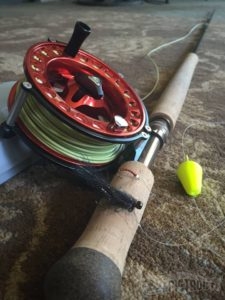
As far as casting is concerned it’s still tough for me to pull off a 100’ er, while trying to execute a “switch cast”. You know the one that is really a modified roll cast with a short anchor, big D loop. Instead what I found was a modification of that with a water loaded Belgian
( https://youtu.be/0tQdBnnO0bA ) Overhead cast works well on the lake while standing on a ladder or chair. Pick the line up off the water allow it to shoot back under the rod, straighten out and shoot it overhead. Nice tight loop that will end up snubbing short at your backing. A proper Roll cast also increased in distance along with being able to work in higher wind velocities. That’s great when standing on shore at some of the steeper beaches or maybe if you are up early enough to get a rock to stand on. So between these two types of casts you can get away with most of the issues faced at the windy lake. Also I have found that offhand cast, casting over your non-dominant side is much easier now with the use of of two hands instead of one. So much so that I find my self casting offhand even when I don’t have to. The one thing that helped me the most was instead of trying to match what the steelheaders were doing on the river, casting wise, and just going with what worked for me allowed me to have more fun and increase my casting ease. Maybe someday I will be able to flick out a 110’ Perry Poke or Snap Rolling Snake but its not mandatory in fact I would say don’t go that route not initially. Learn your own way or take lessons but at this point the internet is not the key to learn how to cast a switch rod.
A few unfounded concerns were put to rest in the first initial days of fishing the #broodpond. Am I going to miss bites on the indicator due to the rod length and action? Not really, in fact with the added length of the rod, being over 11 feet long I think there may have been an increase in hook up ratio at normal 40 foot distance and a for sure increase in hook ups at 70 feet. This brings up another point, positive for the switch rod-it is now possible to feasibly fish an indicator rig out beyond 50 feet, even to 70 or 80 feet from shore or ladder. Not only can you cast the junk that far, but like I stated, you can set the hook at that distance and with a long leader. Another thing that had me wondering was getting the fish in the net. So far this also hasn’t been an issue. I plant the fighting butt into my hip and pull back on the rod and the fish skates into the net. Same thing with larger models in shallow water, hasn’t been an issue( https:// youtu.be/MSpKJOfvU34 ). Once they are ready to come to net then just pull back and let the rod do the work. Strip strikes are essential, since you are working with an overall slower more parabolic action of the rod you don’t want to be raising up for the standard “trout strike”. When you get that bite or it gets heavy, keep stripping, get tight to that fish, then set the hook with a solid sweep of the rod. You have to get all the slack out and start to create a bend in the switch rod to make solid contact with the fish. Since we are fishing stillwater instead of a river, we don’t have current to help us set the hook and keep tight to the fish.
Everything considered, it has been a great year of fishing the switch rod. Whether I’m on my ladder, fishing off the rocks or standing on a steep beach you will find a switch rod in my hand.
Bruce A Smith


